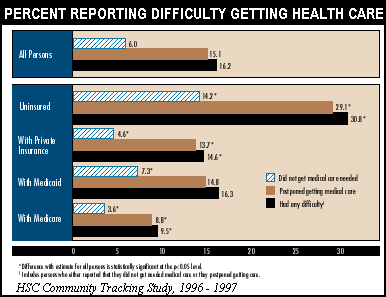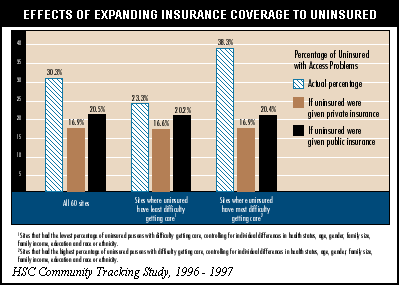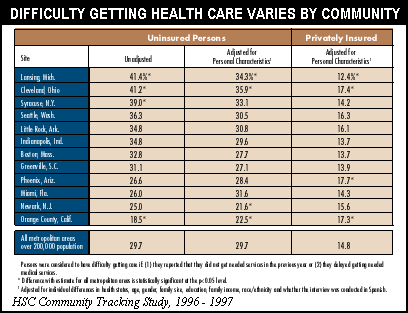
The Uninsured Getting Care:
Where You Live Matters
Issue Brief No. 15
September 1998
Peter J. Cunningham, Peter Kemper
![]() substantial number of Americans--41 million people--do not have health insurance; this represents a 16 percent increase in the uninsured since 1990. Further, many studies show that the uninsured have significantly more difficulty than the insured in getting needed care. This Issue Brief discusses Health System Change (HSC) findings from its Community Tracking Study showing that the ability of those without coverage to get needed care varies considerably across communities. In addition, HSC’s study shows that the personal characteristics of the uninsured explain very little of this regional variation. These findings are the first step in helping decision makers understand how the dynamics of communities and the safety nets within them affect the medically indigents’ ability to obtain needed care.
substantial number of Americans--41 million people--do not have health insurance; this represents a 16 percent increase in the uninsured since 1990. Further, many studies show that the uninsured have significantly more difficulty than the insured in getting needed care. This Issue Brief discusses Health System Change (HSC) findings from its Community Tracking Study showing that the ability of those without coverage to get needed care varies considerably across communities. In addition, HSC’s study shows that the personal characteristics of the uninsured explain very little of this regional variation. These findings are the first step in helping decision makers understand how the dynamics of communities and the safety nets within them affect the medically indigents’ ability to obtain needed care.
Wide Community Variations
![]() he delivery of health care is local, so it is not surprising that there are differences across communities in the ability of the uninsured to obtain medical care. What is surprising, however, is the degree of these differences. For the uninsured, this means
that where you live is an important factor
in determining the difficulty you have in getting care.
he delivery of health care is local, so it is not surprising that there are differences across communities in the ability of the uninsured to obtain medical care. What is surprising, however, is the degree of these differences. For the uninsured, this means
that where you live is an important factor
in determining the difficulty you have in getting care.
Nationally, about 31 percent of uninsured persons reported that they did not get needed medical care in the previous year or had to postpone getting it. This is more than twice the rate for the privately insured (see bar graph below). On the community level, there was more than a twofold difference in the rate of these access difficulties, ranging from more than 40 percent in Lansing and Cleveland, communities that had the highest rates, to less than 20 percent in Orange County, the community with the lowest rate (see table below).

About 15 percent of the variation in getting necessary care across communities is accounted for by differences in the characteristics of the uninsured -- for example, their health status, age, gender, family income and race or ethnicity. Some of the remaining variation is likely due to particular characteristics of the communities that affect access for uninsured persons, which this study did not assess. Such community characteristics are far more difficult to identify than personal characteristics, but major factors may include the number and capacity of safety net providers to serve the medically indigent, state policies that subsidize charity and uncompensated care and the prevalence of managed care.
Variation may also be attributable to factors that are not related to the health system, such as people’s perception about their ability to get medical care and the wealth and size of the community. For example, the uninsured in both the greater Newark area and Orange County have low rates of difficulty in getting care. Both communities are relatively wealthy areas (but with pockets of high poverty) with a higher-than-average supply of physicians, which indicates that these communities have greater health care resources. This may help to explain why physicians in Newark provided more charity care (about 10 hours per month on average) than physicians in any of the other sites, according to HSC’s Physician Survey.
Newark and Orange County are also part of the two largest metropolitan areas in the country -- New York and Los Angeles. Larger areas may expand the options of uninsured persons by allowing them to use safety net facilities in contiguous areas. Some of the medically indigent patients in Orange County, for example, use the more extensive public facilities of nearby Los Angeles County, which may give them better access to care.
While "reported difficulty in obtaining medical care" is the single most direct measure of access available in the HSC survey, it is not based on a clinical assessment of the need for care, but rather on patients’ own assessment of the degree of difficulty they face. In a separate report, HSC also looked at other less direct measures of access, such as the percentage of uninsured without a usual source of care, the number of ambulatory care visits and distance from home or work to the physician’s office. While there was also substantial variation across communities on these measures, the results showed that the pattern of variation across communities is not generally consistent with the percentage reporting difficulty getting care. This has led HSC researchers to conclude that much more work needs to be done to understand how differences in safety nets, local market characteristics and idiosyncratic community attributes affect access for the uninsured.
Comparisons With The Insured Population
![]() onsistent with other studies, HSC found that people with health insurance have less difficulty obtaining care than the uninsured nationally. Only 15 percent of privately insured persons reported having difficulty in getting care. While the ability of the insured to get needed care varied across communities -- from 12 percent in Lansing to 18 percent in Phoenix -- the extent of the variation was less than for their uninsured counterparts.
onsistent with other studies, HSC found that people with health insurance have less difficulty obtaining care than the uninsured nationally. Only 15 percent of privately insured persons reported having difficulty in getting care. While the ability of the insured to get needed care varied across communities -- from 12 percent in Lansing to 18 percent in Phoenix -- the extent of the variation was less than for their uninsured counterparts.
However, the pattern of variation in access for the uninsured and privately insured in terms of their ability to obtain needed care does not correlate. This means, the communities with relatively high levels of access problems among the uninsured do not necessarily have the highest levels of access problems for the privately insured. An example of this is in Orange County, where the uninsured have less difficulty in getting care than the uninsured in most other sites, while the privately insured have greater difficulty than privately insured persons in other sites.
This suggests that the factors affecting the uninsured population’s ability to get needed care are not the same as for the insured population. Indeed, uninsured persons overwhelmingly cited cost concerns (90 percent) as the reason for the difficulty in getting care. While privately insured persons also cited cost concerns (48 percent), they noted problems with health insurance and getting referrals (28 percent) and the ease and convenience of using the system (33 percent).
Policy Implications
![]() ublic and private decision makers concerned about the nation’s health must
now grapple with the implications of access
to needed medical care varying across communities. This Issue Brief does not specifically address why these differences exist, but the reasons are likely to be complex. There may be no simple, effective policy responses to address the differences in access between communities.
ublic and private decision makers concerned about the nation’s health must
now grapple with the implications of access
to needed medical care varying across communities. This Issue Brief does not specifically address why these differences exist, but the reasons are likely to be complex. There may be no simple, effective policy responses to address the differences in access between communities.
- The health care safety net which many policy makers look to for improvements in access to care for the uninsured is not a coordinated and well-integrated system of care in most communities. Rather, it is a patchwork of providers, consisting of public hospitals, community health clinics, local health departments and other individual entities that provide care for the medically indigent on an ad hoc basis. Therefore, designing effective interventions that enhance the safety net is challenging.
- There is little information about how access to care by the uninsured is affected by specific aspects of the safety net, such as whether there is access to preventive and primary care through clinics and physician offices. Pending HSC research will help policy and decision makers better understand what health system factors, such as managed care and the level of uninsured, affect the uninsured’s ability to get charity care.
- There are differences across communities in the degree of importance given to indigent care and the way in which individual communities respond to the uninsured problem. Some of these differences are based on cultural attitudes and some on highly idiosyncratic voluntary efforts. These factors may be beyond the scope of public policy makers to influence.
Extending health coverage to those without coverage would address many of the difficulties the uninsured face in getting needed care and would result in greater uniformity in access across communities. An HSC simulation shows that the percentage of uninsured persons who experienced difficulty getting care would decrease from 30 percent to about 21 percent if they were given Medicaid or some other public coverage, and to 17 percent if they were given private insurance (see bar graph below). This improvement would be relatively consistent across the sites, regardless if the uninsured currently experience more or less difficulty in getting needed care.

The variation across communities in the difficulty of the uninsured getting necessary care is expected to persist or grow even larger in an environment where competition is intensifying and public subsidies are drying up. The already limited federal role in providing care to the medically indigent is likely to shrink, due to decreases in Medicaid and Medicare Disproportionate Share Hospital Payments. As a result, policies to provide care to the uninsured will continue to be driven largely at the state and local level. Understanding how local market conditions affect the uninsured’s ability to get needed care such as the role of managed care and innovations in the local market is critical to designing policies that may enhance care for the uninsured.
Data Source
![]() his Issue Brief is based on data from the Community Tracking Study’s Household Survey, a nationally representative telephone survey of the civilian,
non-institutionalized population as well as
of 60 randomly selected communities. Data were supplemented by in-person interviews of households without telephones to ensure proper representation. Interviews took place between July 1996 and July 1997. The survey contains observations on nearly 33,000 families
and 60,000 individuals.
Of these, 7,200 were uninsured. The overall response rate was 65 percent for families.
his Issue Brief is based on data from the Community Tracking Study’s Household Survey, a nationally representative telephone survey of the civilian,
non-institutionalized population as well as
of 60 randomly selected communities. Data were supplemented by in-person interviews of households without telephones to ensure proper representation. Interviews took place between July 1996 and July 1997. The survey contains observations on nearly 33,000 families
and 60,000 individuals.
Of these, 7,200 were uninsured. The overall response rate was 65 percent for families.
Information on health insurance coverage, health status, health care access and utilization and demo-graphic characteristics was obtained for all adults in the family and one randomly selected child. The data were weighted to be representative of the continental U.S. population and adjusted for survey non-response. Standard errors for use in tests of statistical significance take into account the survey’s complex sample design. All differences between estimates mentioned are statistically significant at the p<0.05 level.
Related Information
![]() his Issue Brief is adapted from "Ability to Get Medical Care for the Uninsured: How Much Does it Vary Across Communities?" by Peter J. Cunningham and Peter Kemper, which appeared in Journal of the American Medical Association, Vol. 280, No. 10 (Sept. 9, 1998).
his Issue Brief is adapted from "Ability to Get Medical Care for the Uninsured: How Much Does it Vary Across Communities?" by Peter J. Cunningham and Peter Kemper, which appeared in Journal of the American Medical Association, Vol. 280, No. 10 (Sept. 9, 1998).
A related article, "How Well Do Communities Perform on Access to Care for the Uninsured?" by Peter J. Cunningham and Heidi Whitmore, appears in a fall issue of HSC’s new publication series, Research Report.
